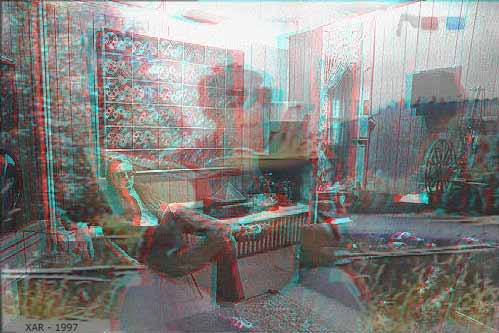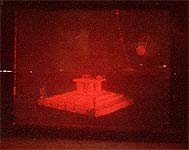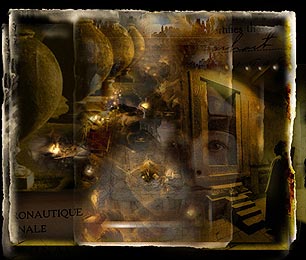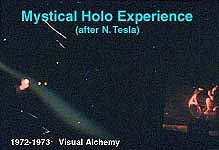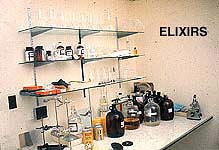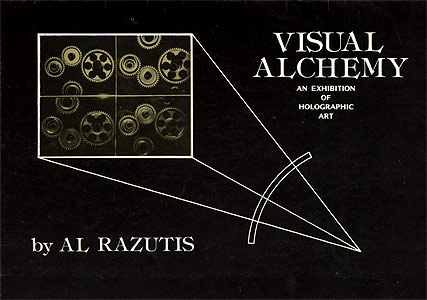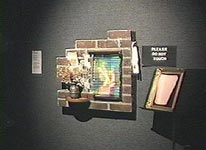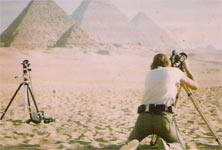'Holographic Intentions' at Visual
Alchemy'
'Leaving Plato's Cave with a Lot of Baggage'
Essays and holography by Al Razutis
'Leaving Plato's Cave with a Lot of Baggage'
Essays and holography by Al Razutis
'Visual Alchemy - then and now'
 ANAGLYPH 3D - use red - blue glasses to view in 3D
ANAGLYPH 3D - use red - blue glasses to view in 3D
The companion piece to 'Holographic History at Visual Alchemy' by studio founder Al Razutis
and the necessary companion piece: 'What is a Hologram?' by studio collaborator Catharine MacTavish.

'What is a Hologram?' (html) by Catharine MacTavish - 2021
A historical, artistic and philosophical treatise on works by Canadian holography pioneer Catharine MacTavish.
Or, download PDF copy of this essay >> 'What is a Hologram?' (11 mB PDF)
'PLATO'S CAVE ' and 'VISUAL ALCHEMY'>
(Film-video imaging-projection, 3D stereoscopic image projection, holographic image projection...)
by Al Razutis (2005, 2010, edits cont.)
'Visual Alchemy'( history) studio, a multi-room black-walled facility offering little in terms of living amenities, but with media and experimental devices in abundance, was my Vancouver studio (from 1973) and my sleeping loft from 1974 to 1977. No kitchen; no showers, but equipment everywhere. Within this facility I created my art, business, held workshops and invited other artists to creat work on a cooperative basis.
The early 1970's was the era where film and video exhibition - gallery - projection theaters and their passive audiences were accustomed to a 'near Platonic Cave experience' with psychedellic and suggested surrealities. Within 'underground cinemas' and 'art happenings', 'rock performances,' there was not only image and sound but perfomance art, multi-media works, poetry, dance and early video.
2020 illustrated essay on Alchemy and Visual Alchemy:
'Visual Alchemy in Theory and Practice, and as Holographic Art'

Further lessons in the alchemies of projection: 'Projecting - Alchemy'
It All Begins with Intermedia and a studio 'cave' painted black
The 'Intermedia' (artist's co-op) of the late 60's in Vancouver was one such place that encouraged and developed cross-disciplinary experimental art forms, and pushed for creating new tools, to explore or create new medias. It was a formative experience for us expatriate and local artists.
Shortly later, after Intermedia closed, in 1972 Vancouver Razutis built his studio Visual Alchemy Inc. to continue is works in film - video - and now holography with custom built equipment, a film optical printer, video synthesizer, a holographic lab with holographic tables and custom built lasers. In the spirit of his 'avant-garde' he would create works outside of the established art worlds of curators and gallery exhibitions. His first public-formal show was in 1977 titled 'Visual Alchemy'.
My works were supported by two Canada Council Senior Arts Grants (Penni Jacques, Film Officer), the National Film Board of Canada (Peter Jones, Senior Producer), and this support came with a shared optimism that 'something interesting was happening and should be supported' among the young experimental filmmakers. Thus, these new works in 'holography' (then, a relatively unknown medium) came about with both government and personal support and efforts.
Early 'cave art' West-Coast style

In my version of the 'cave', I built a film and video studio containing projectors, Edison lamps, lasers as light source, and projected images of reality (and surreality) as motion-picture images, as video television images, as stereoscopic 3D images upon the polarized silver screen, video monitors, and parabollic (plexiglas - mirrored) holographic projection screens. It was here that I created my 'experimental' and 'avant-garde' films, videos, my Moog-synthesizer audio tracks, my 'special effects' and animations, and it was here (where no other such facilities existed for artists in Vancouver) that I provided services for other filmmakers or collaborated on projects with other artists. It was here that possibly Canada's 'first motion-picture holograms' (1974) were created and displayed in laser-lit cylinders with rotating prisms. Images were projected not only onto screens, or in tv vacuum tubes, but also 'in space' using psucoscopic-image hologram projections into spherical or parbollic mirrors, some as large as 4 feet in diameter.
Some of this work would remain 'experiments' and some would be packaged for future exhibition in galleries. There was no hurry; there were near-endless fascinations to be explored. And as for 'business', it always was conducted as a 'break from the expermental' works, and when time and/or inclination permitted. It was not set up to be a 'money making business'; it was first and foremost a laboratory for visual alchemical experiments and works of art and non art.
In the spirit of the times, the projectionist and 'audience-collaborators' (creative 'metaphysical malcontents') became 'restless', demanding more 'interactive media'. And the projections turned to interactive bio-feedback synthesizer video art, pushing the 'envelope' further, and holography and holographic projected images were enlarged to further tempt the viewer in 'interactive spaces'.
Passive ---- Interactive ---- Projected
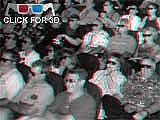


For projecting real and virtual images/worlds also see Projecting - Alchemy
The post-hippie era of the 70's with assorted religious, metaphysical, psychedellic interests in Vancouver was an ideal context for Visual Alchemy. Here at the studio, various experiments in alchemy, Jungian psychology, astrology, numerology and Kaballah, pyramid power, Tesla coils, Kirillian photography and holography were conducted. There were also visits from artists, curators and fellow avant-gardists, and arts administrators. There was a studio visit by magician Harry Blackstone Jr. All of these visitations would inform any future realizations in art and 'objects' and illusion. And the results of these various experiments (working the 'theories', as it were) would take the material form of holograms, film, video, sound, and the various 'dream machines' that were built to conduct these experiments and works of 'art'. A metaphysics 'in progress' was the theme, where the imagination demanded 'adventure', not doctrine and dogma. The fascination with hermetics at Visual Alchemy was not a longing for a long-expired 'golden era', Rosicrucian alchemy, Masonic alchemy, Egyptian alchemy, where Hermes ran the show in front of his pyramids. It was an engagement of 'avant-garde' metaphysics and the 'surrealities' that the imagination seeks to liberate into a world of appearances, and disappearances.
Metaphysics of Light and Dimension
In a scientific-materialist age (what we term the 'modern age'), 'metaphysics' has grown out of fashion. Materialist theories of deconstructing and re-constructing 'culture' have abounded. Sentimentalism is discouraged. Magic is trivialized and re-presented as fascinating parlor 'tricks'. The 'marvelous' is no longer marvelous, but 'textual'. It is as if the protestant puritanism of elevating the 'word' and 'text' above all meanings and doctrine practices, including in culture and the arts, is to be upheld at the supression of 'non word' expressions. It's even tougher on the surrealists, whose imaginations of the marvelous relies not on the word but on the strange encounters of chance, rapture, and enchantments, or forgetfulness.
What then could a 'Visual Alchemy' look like, if not an alchemy of the surreal? This visual alchemy would not be preoccupied with 'measuring', 'explaining', and depicting optical 'proof' of the theories of Gabor, or the hologram as 'empirical subject'. This visual alchemy would not be a re-hash of old hermetic temple scenes (like in Rosicrucian practice), some hokus-pokus witchcraft games, fake astrology and numerology, or 'chaneling' Atlantis of by-gone years. Something 'new', not Medieval old, would be on its mind, and there would certainly have to be 'proof', not vague symbologies understood by no one (else).
This visual alchemy would show the methods and power of the 'transmutation of ideas' where idea becomes form becomes 'the consort' of imagination's 'marvelous body'. Or to put it into medieval terms, an 'infestation of imagination', and not echoes of the mechanical-optical world.
This visual alchemy would have to show the power of 'suggesting' and transforming matter and energy into various forms of the 'marvelous', and not by immitation of classical aesthetics, perspective, and the usual forms of light-projection (images in a 'cave'). This visual alchemy would would show that it is possible to 'will reality into existence', not through mantra and prayer, but through a focus of mind, body, intuition, imagination, and happenschance, all the while enchanted. Enchanted by who? A spirit? Angel? Demon? Enchanged by the act of performing (like singing, without sound) transmutation (not to be confused with 'transformation') of one 'reality' (let's call it 'base') into another 'reality' (let's call it 'gold'), and to be enchanted by the marvelous residing within the changes as created in 'holograms'. No Rosicrucian or other hermetic texts are required. Only a compelling focus (which I call 'active enchantment') which transforms both the observer and the observed as the 'alchemical work' is undertaken and sometimes performed to others.
2020 illustrated essay on Alchemy and Visual Alchemy:
'Alchemy, visual alchemy and their respective arts'

Experimental proofs, not theories and hustling
Consider this experiment, which is part aesthetic labor and part alchemical labor. In this instance, however, we use 'modern' tools: lasers, optical table, film plates, developing and drying rooms. We start by 'imagining' the work, then set the details (object, film plate, optics, etc.) in place. We can be working under the main bridge into a metropolis downtown (as Visual Alchemy, Vancouver was located), a bridge and supports that constantly vibrate to the traffic 24-7. For our experiment, we need absolute stillness. The air can't move, the laser and optics and film plate and object can't move during out exposure period (typically 10 seconds to 2 minutes in the 1970's). And when I use the term 'absolute', I mean it in a relative (to everything in the near environment) way. Absolute stillness is like absolute zero: it is a theoretical limit, not an observable fact. So how do we make everything still? We use 'isolation tables', locked down optics and objects, sound and heat isolation, silence and focus. Why focus? Because it doesn't 'happen' without it. And if it happens at all, because many times the holographic image 'just isn't there' (bad vibration, bad chemistry), one has to repeat, and repeat the procedure, finally 'knowing' the results in advance, finally. So, the proof is the hologram? The proof is the entire procedure, beginning with conception, inspiration, viusualizing the results, and continuing with aesthetic, scientific, metaphysical labors which result in a 'proof' as the image 'materializes' while drying...
We could run an experiment of 'higher dimensions', now that we have the basic three under the inspired grasp of the 'marvelous'. A superimposition of one moment in time with another moment in time (a 'double exposure') would result in interferometric holograms which display amazing ribbon-like 'contours in space' (a visual music) that lie on the edges of 'before' and 'after' and are images of disturbances in time and space. At least you would see this 'music' and its potentials as universal 'sounds', if you had the inclination to see it at all.
The skeptic might say, "Oh, you're just making an image of an object, a hologram, that's all. Isn't this other stuff simply non-destructive testing called interferometric holography?"
But a visual alchemist would reply: "Only if you are deaf and blind to the music and energies around you."
And an artist would reply: ""This is not a pipe!"
And the conclusion might be: It is not simply an empirical subject. No measurements are required of that which is 'marvelous'.
A favorite digression; a walk with J. Karl Bogartte:
Building the alchemical lab - the alchemical theater
How can one explore dimensions without first building the tools, lab, concepts that will reveal how dimensions are created and altered? How can one engage with 'phantom dimensions' when more common (base) dimensions are not comprehended in their mutable forms? How can one understand the vibrations and 'nature' of light - coherent light and incoherent light - without first building the tools, the lasers, the interferometers, that deliver these understandings to a canvas, a 'hologram' or 'interferometric hologram'? Those were some of the tasks that were 'physically realized' (as art, experiment, display) in a visual alchemy that chose its metaphysics very carefully.
In the modern era, not the eras of antiquity or Middle Ages, it is a tough 'sell' for both surrealists and visual alchemists. This materialist-scientific age which has elevated its philosophies to be the task of all 'useful art' (fine art included). While that can be engrossing (and I have certainly practiced po-mo deconstructionist and avant-garde arts), sooner or later I return to the surrealist, alchemical, and anarchist 'enchantments' that have been the source of most of my life's joy, even though as the moth flies into the flame, the moonlit waters amidst the moon lit edifices neither release nor reject me, but coax me into other worlds of adventure and misadventure.
Also gleamed from the pages of J. Karl Bogartte:
|
"The unbearable transparency of the lunatic was in proportion to the beauty of the alchemist's wife, who sews up the golden mummy in a nebulous cat's cradle for the hidden desires of the onlookers, who have long since departed in the eyes of moths."
"How else to explain the presence of luminous receptacles...
in the revelation of light occupying space..." |
"...unlike all of these such damned or blessed virtuality, is a clear
space for free imagination and creative spiritual strategies, in which
the most varied forms can be created and intervention with miraculous
possibilities - standing against all rigid realities." "
It seems quite necessary, at this point in time, that the practice of art
arm itself with a more radical departure, and by hook, or crook
relinquish all claims to exclusivity in this dimension, and to explore
all the others, where we will come to understand
that nothing is impossible if we are in possession of marvelous weapons."
|
2020 illustrated essay on Alchemy and Visual Alchemy:
'Alchemy, visual alchemy and their respective arts'

Further lessons in the alchemies of projection: 'Projecting - Alchemy'
'LEAVING PLATO'S CAVE WITH A LOT OF BAGGAGE'
Holography, Hybrids, Virtual Reality and Holocosmology
Recollections by Al Razutis< (2005, 2010)
Zooming back to historical contexts for the 'VISUAL ALCHEMY' exhibition<
The practice of 'holographic art' - as distinct from scientific and technical imaging - began in Canada in the early 70's at the multi-media studio complex of Al Razutis named 'Visual Alchemy', and soon after was joined by the works of David Hlynsky and Michael Sowdon at Fringe Research and Michael Page in Toronto, and Catharine MacTavish who also who conducted work in Vancouver - Visual Alchemy. Snowdon, Hlynsky and MacTavish were all students of Lon Moore, San Rafael and learned their crafts there before starting up in Canada. Michael Page was a self-taught holographer in Toronto with minimal presence in the arts but high on organizational activities and teaching. All of these people conducted independent works based on varying aesthetics and interests. There was no unified 'Canadian school of holography', nor was one ever intended, or presumed. Vancouver, after all and in the early 70's was 'on its own', and called Terminal City by folks in the east.
The early holograms exhibited in cities were pioneering efforts undertaken by 'holographers' dispersed around the world (New York, Chicago, San Francisco, Los Angeles, Vancouver, Toronto, and in Europe) eager to find the 'boundaries' of this new and exciting 3D imaging process. The distinctions between 'art' and 'science' were typically vague. Razutis' interests in engaging in this work were tied to his interests in spatial imaging, motion-pictures, synthetic expressions, and a peculiar 'virtual reality' that holography expressed. His interests were also 'alchemical', involved in engaging the 're-transformation' of 'material' into 'energy' and 'form'.
'Holocosmology' was also in the air, in the writings of the neuro-physiologist Pribram, the quantum physicist Bohm, and many neo-Pythagoreans who saw a mystical connection between the 'macrocosm' and photonic 'microcosm' as suggested in holography ('The Universe as a Hologram') .
A detailed analysis of the aesthetic and empirical subjects of holography, including remarks on holocosmology, is presented in
'Art and Holography' (5.21 "The Hologrammatical Society"),
a 1985-6 two-part essay by Razutis (Canadian Holography Conference, Wavefront magazine). 'Holocosmology' has changed now to include New PHysics as the informing principle.
The creation of holograms at VISUAL ALCHEMY (1973-1977), a 'neo-Platonic cave' with optical printers, video and audio synthesizers, editing rooms and black-walled environs, located under the main Granville bridge into Vancouver, was accomplished by constant experimentation and home-built technologies (lasers, optical tables, processing rooms).
This studio was certainly a place where experiments with 'Tesla coils', 'Kirilian photography', pyramids, and various hermetic notions were concurrent with the development of the holographic technology and 'alchemical' metaphysics necessary to bring them to a future audience which would want to know the 'hows' and 'whys' of these artistic endeavors. And it was in Vancouver, a 'intermedia' city of international expatriates and Canadian artists, the 'end of the tracks' (Terminal City, as it were), and far from the power 'centers' of art and technology (New York, Toronto, Los Angeles, San Francisco, Chicago, and Europe) that these works were conducted.
Artaud and Visual Alchemy in Banff - Make it theater, make it real
The holographic research at Visual Alchemy was applied by Razutis and Catherine MacTavish in their jointly taught courses at Visual Alchemy (workshops in holography) and later at the Banff Centre in 1974 and 1976 and resulted in student created holograms and experimental theater productions which were a successful integrations of new technology (including motion-picture projections and volume screens) in theatre design. Courses of study included Antonin Artaud and holographic set design and projections.
See my prose-poem essay 'Autopsy of the Patriarch' for a flavor of the times.
Together with the students, Catharine and I worked out theatre designs in holographic image form, imported concepts of 'volume screens' and film and laser projection, and created a public production presented on stage for public viewing "The Traumatized Theater" which was innovative, life-changing for some, and fun for all.
The 'visually alchemical' holograms and the beginnings of stye and genre for 'art'
Even with the extreme limitations of low-powered continuous-wave (He-Ne) lasers, some of the early work featured 'large format' transmissions such as 'Sandscape' - a 2 by 3 foot laser transmission hologram one-shot of long stable duration and some meditation (link to image with object illumination on sand table). Other works, such as Rainforest, explored multi-plate installation and interaction between virtual images and plates. Display holography conceits as to 'size' or image 'brightness' (evidenced in other quarters, namely New York and M.I.T., San Francisco, and particularly 'entertainment' prone Los Angeles) never were a guiding principle at Visual Alchemy Studios.
White-Light Reflection Holography, featured in works such as 'Newtonian Galactic Assembly Line' (and below) - a 4 x 5 foot wall-mounted multi-plate serial-assemblage piece, was an important component of the development of gallery-viewable holograms. More photos here
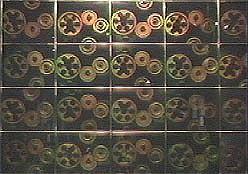
Transmission holograms, by comparison, could only be viewed with laser or specially adapted mercury-vapor lamps and were hardly suited for typical gallery installations. The Newtonian Galactic Assembly Line (left) piece explored holography's unique ability to portray images in a 'inside-out' (pseudoscopic) manner. It was originally designed as a floor piece, but installation limits prevented this original design from being implemented. A number of wall pieces were created on various framing and contextualizing 'devices' to contain, compose, and comment on holography as distinct from graphic represantation. These pieces included Flypaper, Point Source, Newtonian Anagraph, Prima Materia (Invisible Section).
My 'finished' work at "Visual Alchemy" was exhibited in the 1977 exhibition "Visual Alchemy", curated by Elisa Anstis for the Burnaby Art Gallery, Burnaby, Canada, an exhibition which toured during the years 1977-8 across Canada under the supervision of Martin Grove. This tour also featured a large installation of the complete exhibit in Ottawa (1977). a venue that was facilitated and organized by Lorraine Monk - NFB, and opened by the Prime Minister of Canada, Pierre Trudeau.
Beyond the first studio phase - Make it art for an Art Gallery, on pedestals in frames
Being outside of the 'New York Holography' circle - the one orbiting around the Museum of Holography in New York - meant that this work would only be seen in these (and other) touring exhibitions.
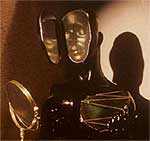
"Surrogate" (left), "Newtonian Galactic Assembly Line", and other works were exhibited in Europe in the early 80's through the notable efforts of Eve Ritscher (U.K.) who was reponsible for a number of high-profile exhibitions in the U.K. (Bath, London, and elsewhere). Ms. Ritscher's U.K. and European tours were one of the significant factors in bringing holography 'out of the various studios' in the 70-80's, and she represents one of the 'unsung' heroines of holographic art in the 80's.
Additional histories including people and dates are at Visual Alchemy Detailed History.
Further work, created in the 80's, was exhibited in various Canadian and international exhibitions, among them an exhibition at the Interference Gallery (Toronto), titled Totem - which was curated by Sidney Dinsmore, and a late 80's exhibition in Vancouver, titled Classic Suite and Other Sories. Also, I participated in touring exhibitions such as 'Canadian Holography Now' - curated by Dinsmore and Michael Sowdon, and the international touring show 'Images in Time and Space', also curated in part by Dinsmore, to bring this work to a wider public.
click for example photo pages from the above shows or sample the decades:
The original silver halide reflection holograms seen in the pages on Hybrid Holography were replaced in the 80's (where noted) by dichromate holograms produced in collaboration with Gary Cullen at Holocrafts, Delta, British Columbia. The continuation of holographic works, once again outside of the influence of New York, or San Francisco holographic circles, is chronicled in both the Hybrids section as well as the section on 'Interferograms as art'.
Razutis Holographic Art Complete List
Leaving the Cave behind, and return elsewhere
A journey to Egypt (1976) by Al Razutis and Catharine MacTavish (National Film Board production - Egypte 1977) revealed to them mysteries of antiquity (and a remarkable meeting with the Egyptologist Dorothy Eady - otherwise known as Omm Sety, "mother of Seti"), and resulted in ongoig works years later that corresponded to a 'different kind of alchemy', one with stereoscopic, then digital and virtual reality 'Platonic caves'.

And so, the 'visual alchemists' of the under-the-bridge studio went separately, taking the 'quantum leaps' that creative imagination requires, and the studio closed a year later.
- Al Razutis 1972- 88 - 05, edits continuing
The necessary disclaimer: These historical essays are imperfect recollections, updated as archives are accessed, or additional facts/documentations are provided by others. As such, they will necessarily feature some omissions in fact, name and date; the process of 'recollection' carries with it the obligation to correct the information whenever new facts emerge.)
REFERENCES AND LINKS:
For Surrealist concepts and "Plato's Cave allegory" see: ''Plato's Cave and the Marvelous in Waiting'
For Alchemical concepts and lessons in the alchemies of projection see: 'Projecting - Alchemy'
HOLOGRAPHIC ARTS - RAZUTIS - MAIN PAGE
PHOTOS OF EARLY WORKS - INSTALLATIONS 1973-1978
Why holographic art has been 'misunderstood':
DISPLAY HOLOGRAPHY: IS IT SCIENCE? IS IT ART?
A videotape survey of 10 artists and their work
VIDEO: 'WEST-COAST ARTISTS IN LIGHT'
History, links to interviews, reviews, articles on holographic art and culture
History, links to interviews, reviews, articles on holographic art and culture
